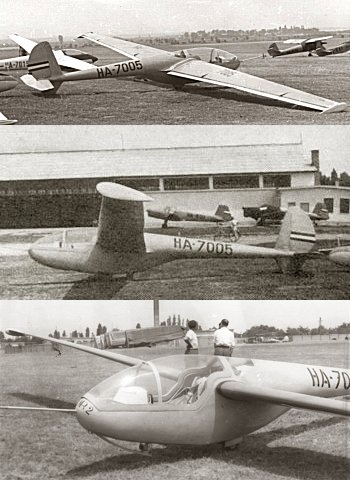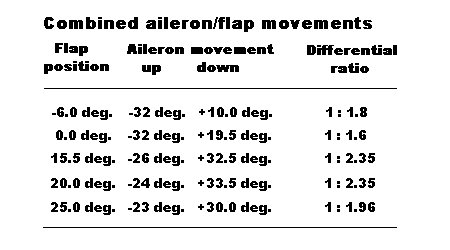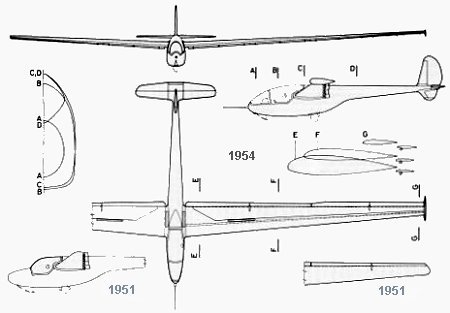HUNGARIAN
GLIDERS
1933-2000
| Type designation: |
Győr-2 |
| Name: |
Győr-2 |
| Designer: |
Aircraft Designer and Builder Group, Aeroclub of the Rolling-stock Factory, Győr |
| Class: |
High performance |
| General arrangement: |
All metal, cantilever, shoulder wing, V tail unit, retractable wheel |
| Crew: |
1 |
| First flight: |
July 18, 1951 |
| Manufacturer: |
Aircraft Designer and Builder Group, Aeroclub of the Rolling-stock Factory, Győr |
| Number of built: |
1 |

Short history:
Evaluating the experiences and observations gained during the international gliding competition held in 1949 at Zar, the leaders of the Aero Club of the Rolling-Stock Factory, Győr, had realized, that the members of the club possess enough skill and energy to design and build a modern high-performance glider. The goal formulated was to create a glider with which pilots would be able to fly gold badge distance legs within Hungarian territory, and they would have opportunities to attempt international records as well.
The new glider was designed by a group - János Balogh, Jenő Kapuvári, Béla Pusztay, Gusztáv Sónyi, dr. Károly Szomolányi - headed by Árpád Lampich. They were supported by the factory, which provided draughtsman work. The organizer of the whole project was dr. Károly Szomolányi.
Preference was given to a metal structure because of the lack of quality timber in Hungary. Another factor was the consideration that a metal structure is more suitable for serial production. Moreover the factory had gained certain experience with metal aircraft structures during the war, as well as there was a residuary stock of light metal sheets and bars from the wartime aircraft production. As at those times there was no way to get of the small quantity of the required special quality steel tubes for the fuselage main frame which the wings connected to, a discarded Air-Cobra fighter's landing gear strut was used to build the main frame.
The construction of the glider, supported by the factory, commenced at the spring of 1950. The project was supported financially by the Hungarian Aeronautical Association (MRSz) as well. The Győr-2 was the first all-metal glider built in Hungary.
The glider first flew in June 18, 1951. The handling characteristics were good at all speed ranges, however when rolling on the ground the ailerons' effectiveness was not satisfactory. The wheel, located well forward of the c.g., contributed to this ineffectiveness. With 28 kg/m2 wing loading the gliding ratios measured were between 37 and 40,6 at gliding speeds of 76-83 km/h. After the initial test flights the glider was moved from Győr to other airfields, however further tests progressed very slowly. By 1952 the glider had become worn and finally was moved back to Győr.
The group started a general overhaul as well as modifications on the glider. The flaps and the control mechanisms were modified. The span of the ailerons was increased and the position of the wheel was changed to a location behind the c.g.
After the modifications the glider's performance was checked by comparison flights with the R-22S Június-18. These tests had shown that the gliding ratio of the Győr-2 surpassed that of the R-22S by 32 % at 80 km/h gliding speed and by 63 % at 110 km/h gliding speed. At that time the Június-18 was the best Hungarian performance glider.
.jpg) The Győr-2 was not certified at this time as the opinion of the aviation authorities was that the materials used might be corroded and the glider is not suitable to safe flying. Finally, after the Aircraft Department of the Technical University of Budapest had approved the glider's documentation, and the structure of the glider had been examined by a committee, an airworthiness certificate was issued.
The Győr-2 was not certified at this time as the opinion of the aviation authorities was that the materials used might be corroded and the glider is not suitable to safe flying. Finally, after the Aircraft Department of the Technical University of Budapest had approved the glider's documentation, and the structure of the glider had been examined by a committee, an airworthiness certificate was issued.
The glider was modified again in 1954, when a new, more streamlined canopy was fitted.
In 1956 performance measurements were carried out on the glider by the Aircraft Department of the Technical University of Budapest. The in-flight measurements were done by Dezső Györgyfalvy (who later became known because of the performance measurements of the Horten-IV glider). Unfortunately this program was not fully concluded. However the results collected during test flights with flap settings of -3, 0, 10, 20 and 30 degrees, had shown a best gliding ratio of 36,8 at 92,5 km/h gliding speed, a gliding ratio of 26,7 at 120 km/h gliding speed, and of 17,7 at 150 km/h gliding speed. Unfortunately the glider was seldom flown and no outstanding flights were recorded. The glider was not fitting into the future development plan of the MRSz, and did not get keen support. In 1957 Nándor Opitz had flown a national speed record of 69,44 km/h with the glider over a 100 km triangle course.
In 1957 the glider was overhauled and in 1958 it had been moved to the Central Workshop of the MRSz, where it was stored and finally discarded. The tools for serial production of the glider, which had been completed at Győr, was delivered to the MRSz as well, however no any other glider was ever built.
The glider was certified for cloud flying and spinning, but not for aerobatics.
If you have Flight Simulator on your computer and would like to fly this superb plane, download gyor2.zip from http://www.flightsim.com
Structure: All metal
Wing:
The Győr-2 was a cantilever, shoulder-wing, all-metal, high-performance glider. The airfoil section at the root was NACA 23 018, at the mid-wing NACA 23 012 and at the wingtips NACA 23 009. No geometric washout was applied. Alongside of the trailing edge of the tapered wing slotted flaperon were fitted. The falperon, having NACA 23 012 airfoil section, consisted of four parts on both sides and was working on differential mode.

On the 1951 version had slantwise cut, rounded wingtips, however in 1957 streamlined end-plates were fitted which served as wing-skids as well. The wing sported Göppingen type airbrakes. The wing root of the original 1951 version could received screw-bolt type solid ballasts of 30 kg on both sides to control the wing-loading.
The booms and the web of the riveted duralumin main spar was made of angle bars and sheets respectively. The wing in front of the main spar was covered by duralumin sheet forming a torsion-box. The other parts of the wing were fabric covered. The very thin flaperon - its thickness was 20 mm at the root and 10 mm at the tip - had a solid wooden spar and was covered by duralumin sheet of 0,5-0,75 mm thickness. Pushrod type control mechanism was used.
.jpg)
Fuselage:
The front part of the fuselage had an elliptical cross section. Behind the wing's trailing edge the cross section of the fuselage decreased dramatically and turned into a tail boom. The cabin was comfortable, the seat and a pedals were adjustable. On the 1951 version the plexiglass canopy had protruded from the fuselage contour, however in 1954 the canopy was modified to streamline into the fuselage. It provided very good visibility and was jettisonable. The landing gear consisted of a nose skid and a wheel, both retractable. The lower part of the vertical stabilizer was strengthened and served as a tail skid. At the 1954 version the Pitot tube was located on a rod protruding 1 m from the nose.
The wing was connected to the fuselage by three pins on both sides. The three pins could have been inserted or pulled out by one movement. The fore part of the fuselage was a steel-tube structure. The fuselage boom was connected to the fore part by four pins. The fuselage was covered by electron sheet sitting on frames made of duralumin sheets.
Tail unit:
The tail had conventional arrangement. The relatively small tail surfaces were compensated by the long fuselage. The horizontal stabilizer together with the elevators could have been folded up to the vertical stabilizer. Both stabilizers were made of electron sheets. The control surfaces were covered by fabric.

| Dimensions: |
| Wing: |
| Span, m: |
17 |
| Area, m2: |
13 |
| Aspect ratio: |
22,3 |
| Chord (root), m: |
1,23 |
| Chord (tip), m: |
0,43 |
| Airfoil (root), m: |
NACA 23018 |
| Airfoil (mid-span), m: |
NACA 23012 |
| Airfoil (tip), m: |
NACA 23009 |
| Dihedral, degree: |
3,0 |
| Sweep, degree: |
3,5 |
| Washout: |
Aerodynamic |
| Aileron: |
| Span, m: |
3,84 (divided surface) |
| Mean chord, m: |
0,104 |
| Total area, m2: |
0,8 |
| Balancing: |
Aerodynamic |
| Flap: |
| Type: |
Junkers |
| Area, m2: |
1,418 |
| Relative length, %: |
0,496 |
| Movement (+/-), degree: |
25/6 |
| Airbrakes: |
| Type: |
Göppingen |
| Position (upside/downside): |
u/d |
| Total area, m2: |
0,44 |
| Position, % of chord: |
0,35 |
| Horizontal stabilizer: |
| Span, m: |
2,8 |
| Area, m2: |
1,31 |
| Elevator: |
| Span, m: |
2,8 |
| Area, m2: |
0,75 |
| Airfoil: |
NACA 0009 |
| Balancing: |
None |
| Trim: |
Yes |
| Vertical stabilizer and rudder: |
| Total area, m2: |
0,81 |
| Rudder area, m2: |
0,35 |
| Balancing: |
Aerodynamic |
| Fuselage: |
| Length, m: |
7,5 |
| Width, m: |
-0,66 |
| Height: |
0,95 |
| Cross section, m2: |
0,51 |
| Landing gear: |
| Type: |
Retractable |
| Wheel diameter, m: |
0,29 |
| Masses: |
| Wing, kg: |
? |
| Fuselage, kg: |
? |
| Tail unit, kg: |
? |
| Empty glider, kg: |
? |
| Gross, kg: |
437 |
| Ballast, kg: |
100 |
| Wing loading, kg/m2: |
33,8 |
| Speeds: |
| VNE, km/h: |
260 |
| Max. speed with open airbrakes, km/h: |
260 |
| Max. aerotow speed, km/h: |
140 |
| Max. winch speed, km/h: |
140 |
| Max. speed in rough air, km/h: |
140 |
| Stall speed, km/h: |
75 |
| Performance: |
| Min. sink, m/s (at gliding speed, km/h): |
0,68/85 |
| Best L/D (at gliding speed, km/h): |
36,8/92 |
| Start methods: |
Winch, Aerotow |

Origin of data and 3-view drawing:
Jereb Gábor: Magyar vitorlázó repülőgépek, Műszaki Könyvkiadó, 1988, Budapest
(Gábor JEREB: Hungarian Gliders, Technical Publishing House, 1988, Budapest)
Gábor FEKECS E-mail: fekecs.gabor@t-online.hu
.jpg) The Győr-2 was not certified at this time as the opinion of the aviation authorities was that the materials used might be corroded and the glider is not suitable to safe flying. Finally, after the Aircraft Department of the Technical University of Budapest had approved the glider's documentation, and the structure of the glider had been examined by a committee, an airworthiness certificate was issued.
The Győr-2 was not certified at this time as the opinion of the aviation authorities was that the materials used might be corroded and the glider is not suitable to safe flying. Finally, after the Aircraft Department of the Technical University of Budapest had approved the glider's documentation, and the structure of the glider had been examined by a committee, an airworthiness certificate was issued.

.jpg)
